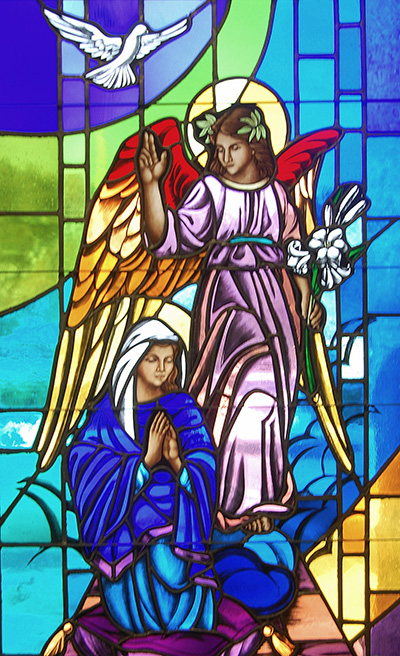
March 25: the fullness of time
Monday, March 20, 2017
*Fr. Eduardo Barrios, SJ
The year’s most celebrated 25th day of the month is in December, the Nativity of the Lord.
However, there is another 25th that deserves emphasis: the one in March, the solemnity of the Annunciation. We understand that the mystery of the Incarnation happened that same day, as it falls just nine months before the birth of Jesus.

Photographer: Jim Davis
This stained glass window at St. Maximilian Kolbe Church in Pembroke Pines depicts the angel Gabriel announcing to a humble Mary that she will bear the Son of God. He holds Easter lilies, a symbol of the death and resurrection of Jesus. A hovering dove symbolizes the Holy Spirit.
To stress the invisible character of a mystery at the border of eternity and time, the liturgy places it at night: “For when peaceful stillness encompassed everything and the night in its swift course was half spent,Your all-powerful word from heaven’s royal throne leapt into the doomed land” (Antiphony to the Magnificat, December 26; Wisdom 18:14-15).
The Mass for the day resembles Christmas, when in reciting the Creed everyone kneels at the words: “And by the power of the Holy Spirit he was born of the Virgin Mary.”
It is a salvific incident that prodigiously touches the tangible. The rationalists do not object to God intervening in souls with his holy inspirations, but they have difficulty when he acts on the tangible. Hence their resistance to mysteries such as the Incarnation, the Resurrection and the Eucharist, divine actions in the tangible and physical.
St. Paul refers to the “fullness of time” (Gal 4:4) as the historical date in which the eternal Son assumes human nature. This first joyful mystery, the Incarnation, is when the end of the history of salvation begins: “In these last days, he spoke to us through a son” (Heb 1:2). By sending Jesus into the world, God has exhausted his revelatory capacity. Nothing essentially new will come after him, only a progressive deepening of the message under the breath of the Holy Spirit, the soul of the Church.
The scene of the Annunciation essentially comes from historical investigations made by the third evangelist. He took the trouble of going back to the eyewitnesses themselves: “I too have decided, after investigating everything accurately anew, to write it down in an orderly sequence for you, most excellent Theophilus” (Lk 1:3).
In order to narrate the Annunciation, the only possible and reliable source was the recipient of the announcement, the Virgin Mary herself, who is said to have “kept all these things, reflecting on them in her heart” (Lk 2:19,51).
First, such a singular announcement must emphasize the name of the one who would be born. He will be called “Jesus,” a name that expresses his identity and mission: the Savior is coming to save us. Second, he arrives as the king of an eternal kingdom. The eternal character of his reign has been incorporated into the liturgical Creed: “And his kingdom will have no end.”
As for the mode of conception, the announcement says, “the Holy Spirit will come upon you.” The action of the third divine person could not be other than spiritual. We can compare the action of the Paraclete upon Mary to the intervention of the Spirit in the Liturgy. In order for Jesus to be present, transubstantiating the bread and wine in the Eucharistic celebration, the Holy Spirit is first invoked with a prayer called epiclesis: “Let your Spirit come upon these gifts to make them holy, so that they may become for us the body and blood of our Lord, Jesus Christ.”
When the angelic announcement is over, Mary remains in meditation. She, the most prudent virgin, ponders and discerns how to respond to such a magnificent and unusual proposal, to become the virgin mother of the Son of the Most High. In a sermon, the mellifluous doctor St. Bernard impatiently awaits Mary's answer and urges her to answer in the affirmative: “Why do you delay, why are you afraid? Believe, give praise, and receive. Open your heart to faith, O blessed Virgin, your lips to praise, your womb to the Creator. See, the desired of all nations is at your door, knocking to enter.” (Office of Readings, December 20).
Mary does not want to have any personal project outside the plan of God. As the representative of humanity, she finally and freely accepts the mission of allowing the eternal Word to become flesh in her (cf. Jn 1:14). She gives her consent with this lapidary answer: “Behold, I am the handmaid of the Lord. May it be done to me according to your word” (Lk 1:38).
God, who always has been close to his people, becomes closer in a new and even more radical way after that fiat (“let it be”). He turns forever into Emmanuel, “God is with us” (Mt 1:23).
On every Sunday and other days of precept, we profess our faith in the Incarnation of the Son of God, affirming that “For us men and for our salvation, he came down from heaven:by the power of the Holy Spirit he was born of the Virgin Mary, and became man.”

